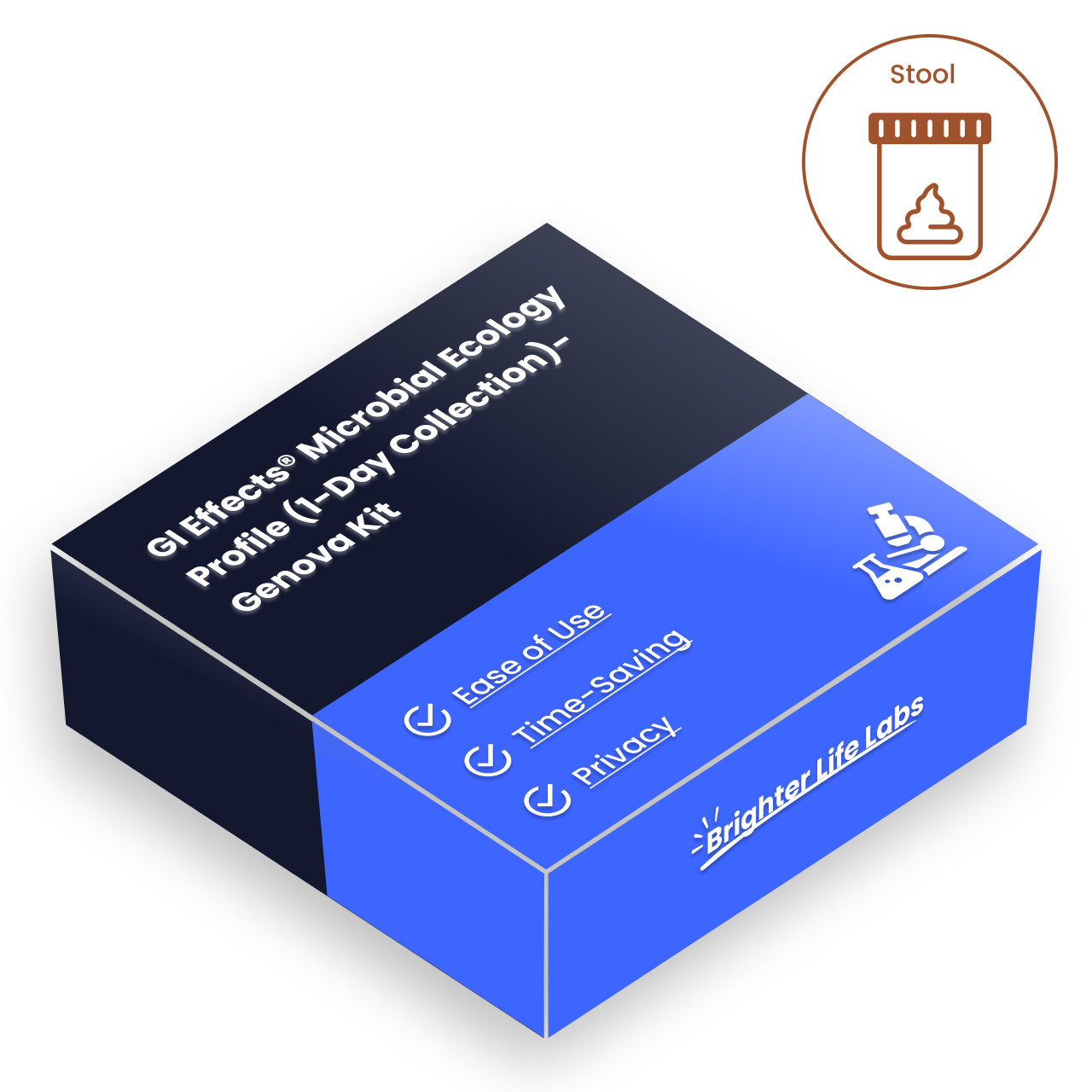1
/
of
1
Genova
GI Effects® Microbial Ecology Profile (1-Day Collection)-Genova Kit
GI Effects® Microbial Ecology Profile (1-Day Collection)-Genova Kit
Regular price
$525.00 USD
Regular price
Sale price
$525.00 USD
Unit price
/
per
Shipping calculated at checkout.
Couldn't load pickup availability
Note: This is a home collection test kit that will be mailed to you. NOT to be used for children under the age of 2. This is a three day collection kit.
Fasting Required:
No
Lab:
Genova Diagnostics
Specimen:
Stool
Results:
Average processing time 14-21 business days
Note: Result turnaround times are an estimate and are not guaranteed. Our reference lab may need additional time due to weather, holidays, confirmation/repeat testing, or equipment maintenance.
Special Instructions:
Ship to lab Monday-Friday and avoid US holidays which may cause delays. Specimen MUST be shipped within 24 hours of final collection. 4 weeks before collection: Wait at least 4 weeks from colonoscopy or barium enema before beginning the test. 2 - 4 weeks before collection: If taking antibiotics, antiparasitics, antifungals, or probiotic supplements (acidophilus, etc.) it is recommended that you wait a minimum of 14 days after your last dose before beginning the test; 28 days may be preferred after antibiotics have been utilized. 14 days before collection: For H. pylori add-on testing, discontinuation of PPIs, antibiotics, and bismuth is recommended. 2 days before collection: Unless directed otherwise by your physician, discontinue aspirin and other NSAIDs (i.e. ibuprofen), rectal suppositories, enemas, activated charcoal, bismuth, betaine HCI, digestive enzymes, antacids, laxatives, mineral oil, castor oil, and bentonite clay.
Description:
The GI Effects Microbial Ecology Profile is the most comprehensive group of stool tests that assess the diverse gut microbiome. Results provide immediate, actionable clinical information for the management of detectable parasites, bacteria, and yeast, as well as providing valuable assessment of gut microbiota via 24 Commensal Bacteria targets. The GI Effects Microbial Ecology Profile is part of the larger GI Effects Comprehensive Stool Profile, which also provides information about digestion, inflammation, and bacterial metabolism markers. A larger fecal biomarker panel such as the GI Effects Comprehensive Stool Profile offers the advantage of assessing multiple functional areas that may be contributing to symptoms. For example, diarrhea could stem from multiple causes including pancreatic exocrine insufficiency, inflammation, food allergies, or the presence of a pathogenic or potentially pathogenic organism.
The GI Effects Microbial Ecology Profile biomarkers include:
Commensal Bacteria
demonstrate the gut microbiomes composition and relative abundance. More than 95% of commensal gut organisms are anaerobic and are difficult to recover by traditional (aerobic) culture techniques. Polymerase Chain Reaction (PCR) methodology identifies bacterial populations and is considered the standard for anaerobic bacteria assessment. GI Effects assesses a set of 24 genera/species that map to 7 major phyla.
Bacterial and mycology cultures
demonstrate the presence of specific beneficial and pathological organisms.
Bacteria and mycology sensitivities
are provided for pathogenic or potentially pathogenic cultured organisms. The report includes effective prescriptive and natural agents.
Parasitology.
GI Effects provides microscopic fecal specimen examination for ova and parasites (O&P), the gold standard of diagnosis for many parasites. Enzyme immunoassay (EIA), widely recognized for its diagnostic utility in the detection of pathogenic antigens, is used for the identification of Cryptosporidium, Entamoeba histolytica, and Giardia lamblia. 6 Polymerase chain reaction (PCR) targets detect common protozoan parasites including Blastocystis spp. with reflex subtyping 1-9, Cryptosporidium spp., Cyclospora cayetanensis, Dientamoeba fragilis, Entamoeba histolytica, and Giardia. PCR for organisms is emerging as a highly sensitive method for infectious organism detection. Selection of a one-day or three-day sample collection is based on clinician's clinical index of suspicion for parasitic infection. If there is no/low suspicion, a one-day sample will likely be adequate. For high suspicion, a three-day sample collection is optimal.
Analytes Reported:
Akkermansia muciniphila Anaerotruncus colihominis Bacteriology Bacteroides vulgatus Bacteroides-Prevotella group Barnesiella spp. Bifidobacterium longum Bifidobacterium spp. Butyrivibrio crossotus Clostridium spp. Collinsella aerofaciens Color Consistency Coprococcus eutactus Desulfovibrio piger Escherichia coli Faecalibacterium prausnitzii Fecal Occult Blood Firmicutes/Bacteroidetes (F/B Ratio) Fusobacterium spp. Lactobacillus spp. Methanobrevibacter smithii Mic Sensitivities, Yeast or Bacteria Microscopic Exam Results Mycology (Yeast/Fungi) Odoribacter spp. Other Biomarkers Oxalobacter formigenes Parasitology Prevotella spp. Pseudoflavonifractor spp. Roseburia spp. Ruminococcus spp. Veillonella spp.
Additional Biomarkers Available for add-on at additional cost:
Campylobacter specific antigen EIA Clostridium difficile EIA Enterohemorrhagic E. coli Shiga-like toxin Helicobacter pylori Antigen EIA Fecal Lactoferrin Macroscopic/Direct Exam for Parasites KOH Preparation for Yeast Zonulin Family Peptide, Stool
Share


